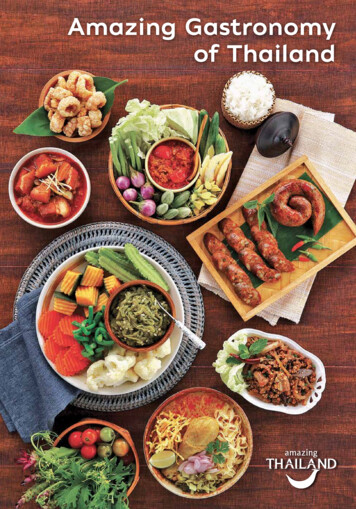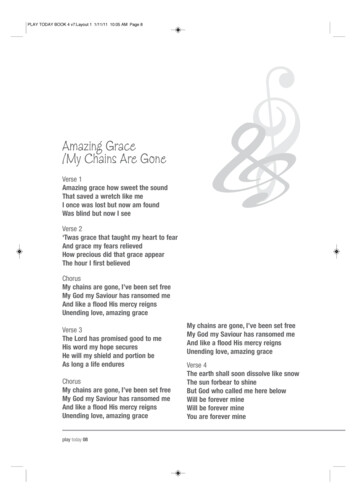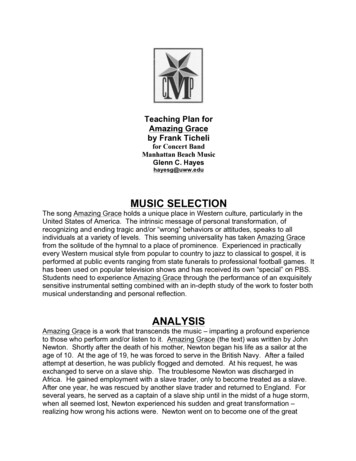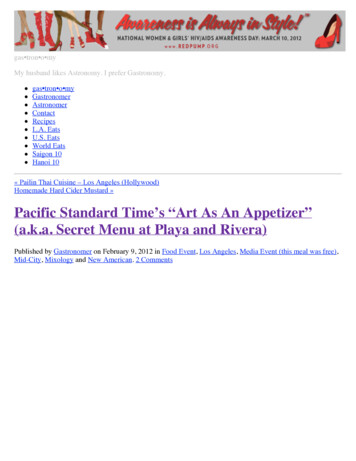
Transcription
Amazing GastronomyAmazing Tastes of Thailandof Thailand
CONTENTSDiscover the amazing tastes of Thai cuisine 4Explore the exotic flavours of Thai cuisine7Thai Rice Thai Way of Life 13The use of Thai herbs in Thai cooking 14Thai Fruits 16Thai Desserts 19Thai Beverages 21Discover non-Thai culinary delights in Thailand 21Street Food in Thailand22Dining in Paradise26Learning to cook Thai cuisine 28Recipes of famous Thai dishes 35
Discoverthe amazing tastesof Thai cuisineDiscover the amazing tastes ofThai cuisineThailand is considered a ‘paradise’ not only for itsbreathtaking beauty and inspiring culture but alsofor its culinary brilliance. From the dynamic lifestyle ofBangkok to the serene seaside towns in the South andtranquil villages along the Mekong River, Thai cuisineis as rich and diverse as its culture. Uniquely craftedto appeal to all tastes, Thai food combines the best offlavours, textures, colours, and presentation. Add this tothe country’s wealth of ancient cooking secrets and Thaihospitality and you find a culinary treasure trove thatoffers an enriching and memorable dining experience.4Amazing Gastronomy of ThailandExquisite culinary heritageThai food is known for its flavours and use of herbs,spices, and market-fresh ingredients. An excitingcombination of five fundamental tastes – hot,sweet, sour, salty, and bitter – brings contrasting yetcomplementary flavours and textures to each dish.Coconut milk, seafood, and fruit also play a key part inThai cuisine. The essence of authentic Thai cuisine liesin its herbs and spices and they have contributed tothe making of time-honoured dishes that reflects thetrue spirit of Thailand.The art of Thai cooking consists of a unique localwisdom that has been passed down from generation
to generation and culinary skills by which Thaichefs meticulously transform local ingredients intobeautifully presented and delicious dishes. Thai dishesare a sight to behold, decorated with graceful fruitand vegetable carvings, each with its own history andmeaning.Having a Thai meal the Thai wayFor Thais, meals are informal affairs involving a circle offamily and/or friends sitting around the table sharinga variety of dishes. A fork and a spoon are usually usedthroughout the meal but there are some exceptions.Chopsticks are ideal when eating noodles, whilefingers are perfect for eating sticky rice or dipping rawvegetables in Nam Phrik (spicy dips).A typical Thai meal consists of rice with manycomplementary dishes served concurrently. Dishes;such as, stir-fried vegetables, soup (Tom Yam Kungor Tom Kha Kai, for instance), and curry, spicy salads;such as, spicy minced pork salad (Lap Mu) or spicyvermicelli salad (Yam Wunsen), and one or more basicsauces usually appear in a full Thai meal. Rice, eitherordinary or glutinous, is served on individual plates.The rest of the dishes are put in the middle of thetable for everyone to share. Desserts may consist offresh fruit or one of the many traditional Thai sweets.Amazing Gastronomy of Thailand5
6Amazing Gastronomy of Thailand
Explore the exotic flavours ofThai cuisineAlthough Thai cuisine is known across the world for itsvariety of flavours, it is better to consider Thai cuisineas an umbrella term that encompasses the cuisines ofthe country’s five regions – Central, Northern, Northeastern, Eastern, and Southern. Each region boasts itsown distinct culinary specialties, providing you witha gastronomic adventure to explore the amazingdiversity and exotic flavours of Thai cuisine.Central RegionFood from the Central region is probably the mostfamiliar and is closest to what people all around theworld know as ‘Thai food’. Central region is home tothe famous fragrant jasmine rice and people livingin this region prefer to eat their food with steamedrice. This region is also the birthplace of some of themost classic Thai food; such as, Tom Yam Kung (hotand sour shrimp soup), Phat Thai (Thai-style stir-friednoodles), and Kaeng Khiao Wan (green curry), justto name a few. A wide range of Nam Phrik (chilli dip)served with an assortment of vegetables is widelyconsumed, particularly Namphrik Kapi (chilli dipmade with shrimp paste) and deep-fried mackerel.Also, Sino-Thai food, which is the combination of Thaiand Chinese cuisine in the form of noodle dishes, isalso popular.Some of the restaurants where you can enjoy the tasteof Central region food, as well as some favourite dishesfrom other regions includes:Baan KhanithaAddress: 36/1 Soi Sukhumvit 23, Khwaeng KhlongToei Nuea, Khet Watthana, BangkokTel.: 66 2258 4181, 66 2258 4128Website: www.baan-khanitha.comBlue ElephantAddress: 233 Sathon Tai Road, Khwaeng Yannawa,Khet Sathon, BangkokTel.: 66 2673 9353-4, 66 2673 9356Website: www.blueelephant.comIssaya Siamese ClubAddress: 4 Soi Si Akson, Chuea Phloeng Road, KhwaengThung Maha Mek, Khet Sathon, BangkokTel.: 66 2672 9040-1, 666 2787 8768Website: www.issaya.comKrua ApsornAddress: 503 Sam Sen Road, Khwaeng Dusit, KhetDusit, BangkokTel.: 66 2668 8788, 66 2241 8528Website: www.kruaapsorn.comNahmAddress: Ground Floor, COMO Metropolitan, 27 SathonTai Road, Khwaeng Thung Maha Mek, Khet Sathon,BangkokTel.: 66 2625 3388Website: ara Thai CuisineAddress: Lower Ground Floor, Erawan Bangkok Mall,494 Ratchadamri Road, Khwaeng Pathum Wan, KhetPathum Wan, BangkokTel.: 66 2250 7707-8Website: www.naracuisine.comPatara Fine Thai CuisineAddress: 375 Soi Thong Lo 19, Sukhumvit 55, KhwaengKhlong Tan Nuea, Khet Watthana, BangkokTel.: 66 2185 2960-1Website: www.patarathailand.comSala Rim NaamAddress: Mandarin Oriental Bangkok, 48 OrientalAvenue,Khwaeng Bang Rak, Khet Bang Rak, BangkokTel.: 66 2659 9000 ext. 7330Website: fine iga Eating RoomAddress: 160/11 SoiThong Lo 6, Sukhumvit 55, KhwaengKhlong Tan Nuea, Khet Watthana, BangkokTel.: 66 2714 7508Website: www.supannigaeatingroom.comThanyingAddress: 10 Pramuan Road, Khwaeng Silom, Khet BangRak, BangkokTel.: 66 2236 4361, 66 2235 0371Website: www.thanying.comAmazing Gastronomy of Thailand7
Northern RegionThe Northern Thai cuisine is generally milder than those ofother regions and is usually eaten with Khao Niao (stickyrice). Some of the popular Northern food includes Sai Ua(spicy herbal pork sausage), Kaeng Hang Le (stewed porkcurry), Namphrik Num (green chilli dip), Namphrik Ong(tomato and pork chilli dip), and Naem (fermented pork).Another famous dish is Khao Soi, which is a coconutbased curry with soft egg noodles and a choice of meat,usually chicken, and topped with crispy egg noodles,lime, onion, roasted chilli, and pickled cabbage. Visitorsto the Northern region, particularly Chiang Mai province,should not miss a Khantok dinner, which involves thediners sitting in a circle around a Tok (pedestal tray), onwhich a variety of northern-styled dishes are served.Some of the restaurants in the Northern region andalso in Bangkok where you can enjoy the taste ofNorthern region food:Khum Khantoke – Chiang MaiAddress: 139 Mu 4, Tambon Nong Pa Khrang, AmphoeMueang Chiang Mai, Chiang MaiTel.: 668 6428 8593Website: www.khumkhantoke.com8Amazing Gastronomy of ThailandTong Tem Toh – Chiang MaiAddress: 11 Nimmanhemin Road Soi 13, TambonSuthep, Amphoe Mueang Chiang Mai, Chiang MaiTel.: 66 5389 4701Website: www.facebook.com/TongTemTohSabunnga – Chiang RaiAddress: 226/50-55 Sankhongnoi Road Soi 6, TambolRop Wiang, Amphoe Mueang Chiang Rai, Chiang RaiTel.: 66 5371 2290, 66 5371 6440Website: www.sabunngahostel.comHuen Lumphun – BangkokAddress: 64/233 Mu 5, Suan Phak Road Soi 35, KhwaengChim Phli, Khet Taling Chan, BangkokTel.: 66 2448 4847, 668 1827 2525Website: www.huenlumphun.comMaan Muang – BangkokAddress: 165/7 Ramkhamhaeng 112, RamkhamhaengRoad, Khwaeng Saphan Sung, Khet Saphan Sung,BangkokTel.: 66 2729 6275Website: www.facebook.com/maanmuang
Northeastern RegionAlso known as Isan, the Northeastern region is home tothe famous Som Tam (green papaya salad). Isan food isenjoyed not only in the Northeastern region, but alsoeverywhere in Thailand. Influenced by Lao cuisine, foodfrom this region tends to be spicy and is often cookedwith herbs and spice. An important ingredient, whichis originated from Isan is the strong-smelled Pla Ra(fermented fish), in which the local Isan people love toput in their food. Khao Niao (sticky rice) is the staplediet and is often accompanied by Som Tam, Kai Yang(grilled chicken), and Lap (spicy minced meat salad).Another local menu is Saikrok Isan (Isan sausage),which has sour taste from fermented minced porkand sticky rice. It is usually eaten with fresh cabbage,sliced ginger, and chili.Some of the restaurants in the Northeastern regionand also in Bangkok where you can enjoy the taste ofNortheastern region food:Somtum Pe Arht – Nakhon RatchasimaAddress: Soi Khotchasan, Thakoengphon Road, TambonSuranari, Amphoe Mueang Nakhon Ratchasima,Nakhon RatchasimaTel.: 668 1548 0637Website: www.facebook.com/SomtampearhtTong Pla Phao – Khon KaenAddress: 95 Si Nuan Road, Tambon Nai Mueang,Amphoe Mueang Khon Kaen, Khon KaenTel.: 668 5014 4140VIP Somtum Club – Khon KaenAddress: Soi Adunyaram 1/3, Tambon Nai Mueang,Amphoe Mueang Khon Kaen, Khon KaenTel.: 669 6332 2363Website: www.facebook.com/teedanunPolo Fried Chicken – BangkokAddress: 137/1-2 Soi Sanam Khli (Soi Polo), WitthayuRoad, Khwaeng Lumphini, Khet Pathum Wan, BangkokTel.: 66 2252 2252Somtum Der – BangkokAddress: 5/5 Saladaeng Road, Khwaeng Silom, KhetBang Rak, BangkokTel.: 66 2632 4499Website: www.somtumder.comAmazing Gastronomy of Thailand9
Southern RegionFood from the Southern region is characterised bythe use of herbs, the intense spicy, sour, and saltyflavours, and is often made from fresh seafood andcoconuts. Sato or stink bean is widely consumed andis usually stir-fried with shrimp paste and shrimp.Other popular dishes include Kaeng Tai Pla (fieryand salty curry made from fish entrails, fish, andvegetables), Khua Kling (stir-fried minced pork withcurry paste and herbs), Kaeng Som (spicy and souryellow curry made from turmeric and tamarind),and Namphrik Kung Siap (spicy shrimp paste withcrispy dried shrimp). A classic dish called Khao Yam(rice salad) is healthy and unique as it featuresan assortment of vegetables and herbs, tossing withrice, toasted coconut flakes, dried shrimp flakes,and salad dressing made from fermented fish calledBudu.Some of the restaurants in the Southern region andalso in Bangkok where you can enjoy the taste ofSouthern region food:10Amazing Gastronomy of ThailandRaya – PhuketAddress: 48 Dibuk Tat Mai Road, Tambon Talat Yai,Amphoe Mueang Phuket, PhuketTel.: 66 7621 8155Tu Kab Khao– PhuketAddress: 8 Phang-nga Road, Tambon Talat Yai, AmphoeMueang Phuket, PhuketTel.: 66 7660 8888Website: www.facebook.com/tukabkhaoNong Joke – KrabiAddress: 50/3 Mu 7, Khongkha Road, Tambon Sai Thai,Amphoe Mueang Krabi, KrabiTel.: 66 7561 1639Website: www.facebook.com/NongjokeKrabiKhua Kling Pak Sod – BangkokAddress: 21/32 Soi Sukhumvit 29, Sukhumvit Road,Khwaeng Khlong Toei Nuea, Khet Watthana, BangkokTel.: 66 2259 5189, 669 5363 6364Website: www.khuaklingpaksod.comPrai Raya Phuket Cuisine – BangkokAddress: 59 Sukhumvit Soi 8, Sukhumvit Road,Khwaeng Khlong Toei, Khet Khlong Toei, BangkokTel.: 66 2253 5556, 669 1878 9959Website: www.facebook.com/PraiRayaPhuket
Eastern RegionEastern region cuisine is the least known cuisine,comparing with food from other regions. Endowedwith abundant resources, particularly seafood andfruits, the eastern region is blessed with many uniquedishes. Apart from fresh seafood, some popular dishesinclude Kaeng Mu Chamuang (pork stewed witharomatic Chamuang leaves), Kai Tom Rakam (spicyand sour chicken soup in which the sourness comesfrom salacca instead of lime), and Namphrik Khai Pu(chilli dip with crab roe). Chanthaburi province is theorigin of Sen Chan (rice noodle used in making PhatThai) and is famous for a dish called Sen Chan Phat Pu(stir-fried Sen Chan with crab meat). Another famousitem from the Eastern region is Khao Lam (stickyrice mixed with coconut milk in bamboo tube) fromChon Buri province.Some of the restaurants in the Eastern region and alsoin Bangkok where you can enjoy the taste of Easternregion food:Chanthorn Restaurant – ChanthaburiAddress: 86/20 Maharat Road, Tambon Talat, AmphoeMueang Chanthaburi, ChanthaburiTel.: 66 3932 7179Website: www.facebook.com/ChanthornrestaurantKrua Maneechan – ChanthaburiAddress: 110 Mu 11, Sukhumvit Road, TambonPhlapphla, Amphoe Mueang Chanthaburi, ChanthaburiTel.: 66 3937 3666, 668 1311 2952Website: www.maneechan.comThiw Thara - TratAddress: 185 Mu 3, Tambon Nong Sano, AmphoeMueang Trat, TratTel.: 668 0575 3598, 669 6908 1528Website: www.facebook.com/BanThiwTharaKhrua Khu Mu – RayongAddress: 139 Yom Chinda Road, Tambon Tha Pradu,Amphoe Mueang Rayong, RayongTel.: 668 9404 9841, 66 3861 3725Sri Trat – BangkokAddress: 90 Soi Sukhumvit 33, Khwaeng Khlong TanNuea, Khet Watthana, BangkokTel.: 66 2088 0968Website: www.sritrat.comAmazing Gastronomy of Thailand11
12Amazing Gastronomy of Thailand
Thai Rice Thai Way of LifeThailand has long been known as the “rice bowl of Asia”.Rice is the staple diet of Thai people and the soul ofThai meal. The phrase “kin khao” literally translates to“eat rice” but it actually means to “eat food” or “havea meal”. Thai meal typically consists of “khao” (rice) asthe centre piece, with many accompaniment dishes,which are referred to as “Kap Khao” (things eaten withrice). Rice is such an important part of the Thai culturethat a common greeting is “kin khao rue yang” whichmeans “have you eaten (rice) yet?”.There are many rice varieties that are indigenous toThailand, but the most famous and most esteemedThai rice is “Khao Hom Mali”, internationally known as“jasmine rice”. The long-grain rice with glossy exterioris unique for its delicate floral aroma and the colourthat is as white as the jasmine flower. When cooked,Khao Hom Mali turns tender, light, and fluffy, and itsaroma becomes stronger and appetising. Jasmine riceis best steamed and it is considered one of the best ricevarieties to accompany Thai dishes.Apart from Khao Hom Mali, “Khao Niao”, which literallytranslates to “sticky rice”, is widely eaten in Thailand.Khao Niao or glutinous rice has shorter grains thanKhao Hom Mali, and as its name suggests, it is sticky.Often eaten by hands, Khao Niao is the mainstay oflocal cuisines in the Northern and Northeastern parts ofThailand. It is also used in making several Thai desserts,most importantly, the famous Khao Niao Ma Muangor sticky rice and mango.One of the delicious and unique sticky rice is called“KhaoLuem Phua”, literally translates to “forget husband rice”.The taste, fragrance, and softness of this black sticky ricecontribute to make it so delicious that it is said the wifewill eat it all and forget to leave some for her husband,hence the name “forget husband rice”. Khao Luem Phuais highly nutritious and is grown by Hmong hill tribes inthe Northern region of Thailand.Thai people also consume several kinds of brownrice.One of the notable varieties is “Khao Hang Ngok”or germinated brown rice, which is the result of thelocal wisdom of Thai people. Khao Hang Ngok is full ofnutrients known as gamma-aminobutyric acid (GABA),which helps alleviating stress, and has softer texture andis easier to digest than regular brown rice.Another kind of brown rice is “Khao Sang Yot”,a traditional variety that originated from Phatthalungprovince in Southern Thailand. The long and slim darkred grain of Khao Sang Yot gives gentle fragrance andproduces soft and chewy texture, almost like Khao Niao,once it is cooked. Khao Sang Yot is also known to be greatfor health as it is high in vitamins and fibre.The new variety of rice that is becoming a populartype of brown rice among Thai people nowadaysis “riceberry”. This highly nutritious rice variety isa cross-breed of “Jao Hom Nin” (a non-glutinous purplerice) and “Khao Dok Mali 105” (a variety of Khao HomMali). The long and round whole grain is in deep purplecolour and is soft and fragrant when cooked.Cooking tips:To maximize the fragrance and flavour of jasminerice, the absorption or covered pan cooking methodis recommended.Ingredients (for 4-5 servings): 3 cups rice grain 4 cups water 3 pandanus leaves (optional)Cooking method:Put jasmine rice in a large bowl and cover withcold water. Gently swirl the grains between thefingers. The water may become slightly cloudy. Leave the rice to settle. Then drain the wateraway by slowly tipping the bowl. Repeat thisrinsing step a few times to help remove excessstarch and dust. Drain thoroughly. To cook steamed rice, pour water into a potand place the pot over high heat. When boiling,add the rinsed rice and cover with a lid. Stiroccasionally. To add more aroma to the rice place 3 choppedpandanus leaves in the pot when the water hasalmost evaporated. Bring the heat down to the lowest setting andleave to steam for 15 minutes. Then leave to cookfor about 5 minutes. Amazing Gastronomy of Thailand13
The use of Thai herbs in Thai cookingSpices and fresh herbs have played an important role in Thai cuisine for centuries and not only have they addedwonderful tastes and stunning aroma to the food, they have also given tremendous therapeutic value to the diner’shealth. When used in combination, they help achieve a balance of the five fundamental Thai tastes. The followingare some of the herbs commonly used in Thai cooking and are known and available worldwide.BasilThree varieties with differentfragrances are used. The mostcommon is Bai Horapha (SweetBasil) which has a slight aniseedflavour and a reddish purplecolour at the leafstalk. It is oftensprinkled on curries. Othersare Bai Kaphrao (Holy Basil),which has a hotter flavour andis slightly hairy and is oftenstir-fried with meat, and BaiMaenglak (Hoary Basil), a milderform often sprinkled over soupsand salads. When these are notavailable, Western sweet basilmay be used, though the taste issomewhat different.CardamomThe pods or large black seedsare used to flavour and garnishmany dishes. It is also used in aground form.ChilliSeveral different types of chilli(Phrik) are used in Thai cooking.As a general rule, the smallerthe chilli, the hotter it is. Thehottest of all is the tiny red orgreen Phrik Khi Nu, followedby the slightly larger Phrik ChiFa. Dried chillies (Phrik Haeng)and ground chilli powder (PhrikPon) are also used.Coriander (Cilantro)Called Phak Chi in Thai, this isessential to many Thai dishes. Notonly are the leaves used but alsothe stems, roots, and seeds, all ofwhich impart a different flavour.14Amazing Gastronomy of ThailandDillDill or Phak Chi Lao, often usedin Northeastern cuisine, addsa pungent aroma as well astherapeutic value to the dish.Fresh dill leaves are widely usedas a main ingredient in severalsoups and seasoning in fishdishes.GalangalA relative of the ginger root,galangal (Kha) imparts a delicate,unique flavour. It is used fresh,dried, or powdered.GarlicThai garlic (Krathiam) is smallerand sweeter than the Westernvariety. It is used both fresh andpickled in a large number ofclassic dishes.GingerIn addition to galangal, twoother varieties of ginger areused in Thai cooking. The usualone is Khing. The other is Krachai,which has a milder flavour.Kaffir LimeBoth the fruit and leaves of thisshrub, Makrut in Thai, lend adistinctive taste to many Thaidishes. There is no real substitutefor it.LemongrassThis tall, grass-like plant, knownas Takhrai, has small, bulbousroots and a lemony flavour andaroma. The bud and base leavesare chopped and pounded foruse in many dishes, as well asfor a refreshing herbal tea.
LimeUsed principally as a garnishfor fish and main dishes, lime(Manao in Thai) is also freshlysqueezed and mixed with waterand sugar syrup as a beverage.MintFresh leaves of this plant (Saranae)are used for flavouring and forgarnishing in a number of dishes.OnionsIn addition to the large, bulbouscommon variety (Hom Yai),shallots (Hom Lek or Hom Daeng)and scallions (Ton Hom) areused.PeppercornsUsed in both fresh green, driedblack, and ground form, theseare called Phrik Thai and add apeppery flavour to many dishes.TamarindThe pulp of the pod of thetamarind tree (Makham) adds asour taste to a number of meatand fish dishes and soups.TurmericKhamin in Thai, this is anothermember of the ginger family andprovides a bright yellow colourto some Thai curries and Sa Te.Amazing Gastronomy of Thailand15
Thai FruitsHomegrown tropical fruits from Thailand have becomelegendary all over the world. Even more memorableis their heady fragrance, ripe colours, and succulentflavours. Although some fruits are seasonal in Thailand,there is always a wide choice available. Visitors mayrest assured of ample oppor tunity to enjoy amouth-watering variety all year round.Year-round fruitsBanana (Kluai)Approximately twenty different varieties are grown inThailand. The three most popular are Kluai Hom,Kluai Nam Wa, and Kluai Khai. These can be eaten rawwhen young and green as a vegetable with a spicysauce. Unripe bananas are sliced, dried in the sun,and then fried for a snack. In addition, they can begrilled and soaked with syrup, boiled in coconut milkwith salt and sugar, boiled in syrup, smoked in theirskins, or cooked as golden fritters.16Amazing Gastronomy of ThailandPineapple (Sapparot)This fruit with light yellow flesh can either be eatenfresh (a pinch of salt enhances the flavour), or used asan ingredient in cooking; such as, in a spicy soup calledKaeng Khua Sapparot. Alternatively, pineapple can besqueezed to produce a refreshing and fragrant juice.Coconut (Maphrao)Coconut makes a refreshing drink and the soft whiteflesh of a young fruit is delightful as a snack. As desserts,coconut is cooked as custard, or as a candy, as crispystrips cooked in brown syrup and in countless otherforms. Coconut flesh and milk is also widely used inThai cooking, especially in soups and curries.Jackfruit (Khanun)The fruit may have a strong smell but is blessed witha sweet taste. It can be eaten raw as a snack, with icecream, or mixed with other fruits and coconut milk.The cooked seeds are also found in many dishes.
Watermelon (Taeng Mo)Watermelon is known for its sweet and refreshingtaste. It is often eaten dipped in salt following a spicydinner and the juice can be used as a beverage.dessert, mango is accompanied by sticky rice andcoconut milk. Alternatively, raw green mangos can besliced and dipped into Nam Pla Wan (sweet fish sauce).Season: February to MayPomelo (Som O)Pomelo is much sweeter and may need a touch of saltto bring out the best taste, when compared to grapefruit.This Thai version of grapefruit can be eaten fresh oras a dessert. It is also used as an ingredient in severalsalads or squeezed to make a perfect refreshing drink.Mangosteen (Mang Khut)Regarded as the ‘Queen of Fruits,’ this delicious fruithas a thick, dark red skin, and creamy white segmentsinside with a sweet, slightly tart flavour. It can be eatenraw, made into tarts, or added to seafood curries.Season: March to NovemberSeasonal fruitsRambutan (Ngo)An exotic fruit with a bright red skin covered in greentipped hairs, rambutan is a delicious, white fleshy fruit,particularly known for its sweetness. It can be eatenfresh by squeezing the skin open by hand or by cuttingit with a knife. Alternatively, it can be made into jams,ice cream, and even used to make delicious salads.Season: May to OctoberMango (Mamuang)One of Thailand’s most diverse and popular fruits,Thai mango is traditionally eaten ripe. Slice it openlengthwise, remove the large seed, and scoop out thedelicious juicy flesh with a spoon. It can also be eatenunripe in many Thai salads. As Thailand’s signatureAmazing Gastronomy of Thailand17
Rose Apple (Chomphu)Rose apple is a bell-shaped fruit with a glossy, edibleskin that can be either green or pink. It is crisp andslightly acidy in taste, and can be eaten fresh or addedto several salad dishes.Season: January to June and September to OctoberSapodilla (Lamut)La-mut is similar in shape to a small mango. It is eatenwhen ripe by removing the skin and slicing the reddishbrown flesh, and is most usually eaten with otherfruits as a cocktail. Avoid the hard brown seeds inside.Season: March to JuneDurian (Thurian)Regarded as the ‘King of Fruits,’ durian is famous forits distinctive aroma. The creamy golden flesh withinthe spiny exterior is regarded by many as a delicacy.Mangosteen is often eaten after durian to eliminatethe durian’s smell.Season: May to JulyJujube (Phutsa)Known locally as Thai apple, this small, round, sweetfruit can be eaten fresh, processed for fruit juice, ordried.Season: October to FebruaryLychee (Linchi)Common in the North, lychee comes in various forms.Small and round, with a hard seed inside, they can bepeeled, seeded, and eaten. The flesh has a sweet andjuicy taste.Season: April to JuneCustard Apple (Noina)A heart-shaped fruit with a lumpy green skin coveringmasses of sweet scented white flesh, Noina is eatenripe, in coconut milk, or used as a base for a refreshingice cream.Season: May to AugustMarina Plum (Maprang)Peel off the skin and discover a firm, sweet fruitinside. Maprang is eaten ripe. It is often carvedbecause of its firm texture.Season: March to SeptemberFruits for healthGuava (Farang)One of the most popular snacks, guava is high invitamin C and can be eaten when ripe or still green. Itis best eaten when dipped in salt and sugar.Orange (Som Khiao Wan)High in vitamin C, Thai orange is sweeter thanthose usually found in the West, and is eaten as abetween-meals snack, as dessert, or squeezed for thejuice.Papaya (Malako)There are two main varieties found in Thailand,one with red and the other with yellowish-orangeflesh. Unripe papaya is used as a main ingredient inSom Tam, Thailand’s most recognised salad. The ripefruit is also eaten fresh with a few drops of lime juice.18Amazing Gastronomy of Thailand
Thai DessertsThere are a variety of Thai desserts, all of whichare unique, colourful, and flavoursome. The mainingredients of Thai desserts are flour, sugar, andcoconut, while other desserts adapted from foreigncountries to suit the Thai taste are made from eggs.Several Thai desserts require exquisite skills as wellas extensive care and time while preparing, andnumerous desserts with meaningful names are usedin rituals and ceremonies. Many names of dessertsinclude the word ‘Thong,’ meaning gold and signifyingprosperity and glory.Thai people use natural herbs and plants to add colourto the desserts; such as, red from rose petals, greenfrom pandanus leaves, purple or blue from Blue PeaBlossoms, and yellow or orange from egg yolk. Thaidesserts are full of sweet fragrances acquired fromsoaking jasmine in the water or smoking the dessertwith ‘thian op’(traditional Thai incensed candle usedfor cooking).Examples of famous Thai desserts are ‘Khao NiaoMamuang’ (Sweet Sticky Rice with Mango), ‘Luk Chup’(Green Bean Miniature Fruit), ‘Bua Loi’ (Rice Balls inCoconut Milk), ‘Thapthim Krop’ or ‘Crunchy Red Ruby’(Water Chestnut Glazed with pink-coloured flour inCoconut Syrup), and ‘Thong Yip’ (Golden Pinch), ‘ThongYot’ (Golden Droplet) and ‘Foi Thong’(Golden Thread)which are all made from egg yolk and often servedtogether.Amazing Gastronomy of Thailand19
20Amazing Gastronomy of Thailand
Thai BeveragesThailand also features numerous unique and refreshingbeverages; such as, ‘Nam Bai Toei’ (pandanus drink),‘Nam Makham’ (tamarind drink), ‘Namtan Sot’(sugar palm sap drink), ‘Kafae Boran’ (Thai-style icedcoffee), and ‘Cha Yen’ (the famous Thai Tea). Otherherbal drinks which are healthy beverages include‘Nam Takhrai’ (lemongrass drink), ‘Nam Matum’ (Baeldrink), and ‘Nam Krachiap’ (Roselle drink). Anotherrefreshing traditional Thai beverage worth trying is‘Nam Ya Uthai,’ water with a drop of red-coloured‘ya u-thai,’ a medicinal herb with cardio tonic andblood tonic property. Thai fruits; such as, guava juice,tamarind juice, and watermelon juice, are also madeinto flavoursome drinks.Discover non-Thai culinary delightsin ThailandThailand is opening a new world of tastes to travellers,with a vast range of world-class restaurants providingtraditional and/or contemporary non-Thai food –from traditional Italian to grand Cantonese and fromcontemporary Japanese to modern alternative diets – insome of the country’s vibrant cities. Capture theessential elements of the East and West in major citiesand prime tourist destinations; such as, Bangkok,Chiang Mai, Phuket, Ko Samui, and Pattaya. There aremany choices of dining options to please all tastes.Whether you are thinking in terms of a restaurant by theriver or by the sea, a popular meeting place in the city, orcolourful street-side food stalls, you are sure to find whatyou are looking for.Thailand also provides a wide array of gourmet optionsfor travellers from all walks of life. All types of Asianfood; such as, Chinese, Japanese, Vietnamese, andIndian, or non-Asian cuisine; such as, Italian, French, andMediterranean, are prepared by experienced chefs fromthe dishes’ countries of origin. For Muslim travellers, Halalfood is easy to find as many Thai Muslim restaurants areavailable throughout the country. Fusion food is becomingincreasingly popular in Thailand and many Thai restaurantsare now offering Western or Japanese dishes, laced withThai flavour. On the other hand, several Western andnon-Asian restaurants also have Thai-style dishes on theirmenus.Amazing Gastronomy of Thailand21
Street Food in ThailandBangkok is regarded as one of the best cities in theworld for street food, but street food is a part of theThai way of life and it can be found not only in Bangkok,but just about anywhere and anytime in Thailand.Street food is not only convenient but is also i
Thai Way of Life The use of Thai herbs in Thai cooking Thai Fruits Thai Desserts Thai Beverages Discover non-Thai culinary delights in Thailand Street Food in Thailand Dining in Paradise Learning to cook Thai cuisine Recipes of famous Thai dishes 4 7 13 14 16 19 21 21 22 26 28 35. 4 Amaing .










